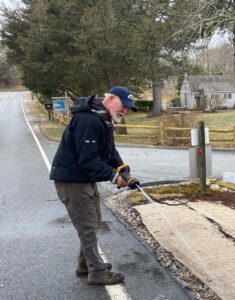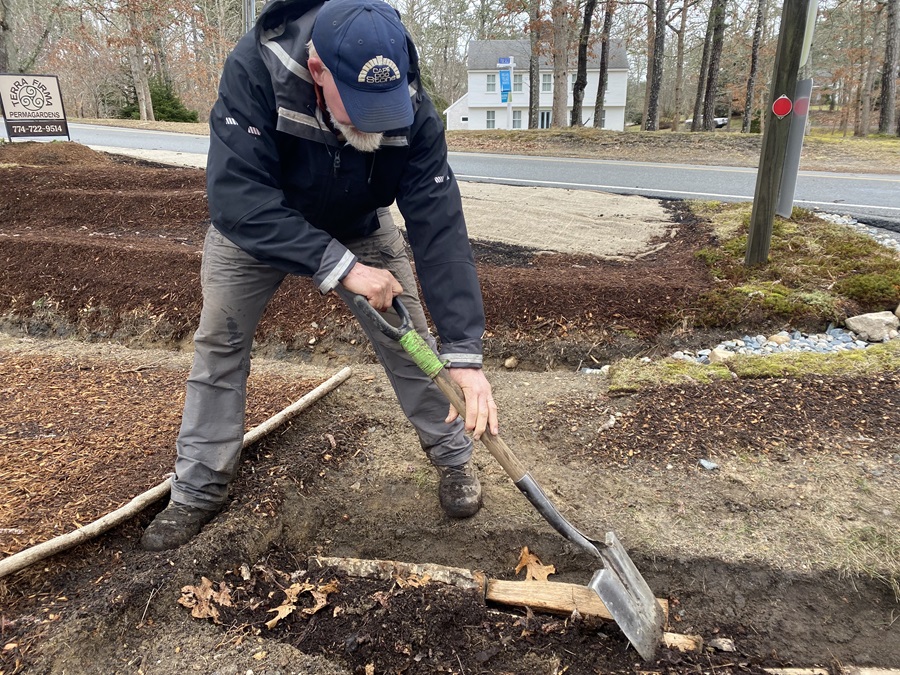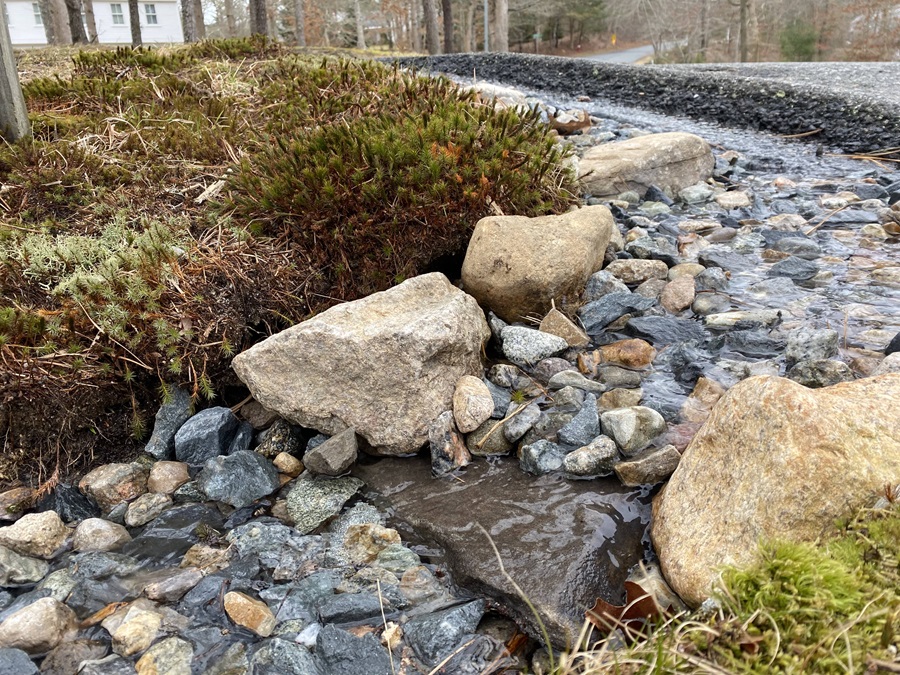ORLEANS — Agroecologist Peter Jensen placed a hose along the road above the Church of the Holy Spirit and turned it on. The water flowed into a dirty channel between the sloping lawn and the church driveway.
He was simulating what happens in a moderate rainstorm and putting a new garden design to the test. He says all the rain that lands between here and 100 meters up the road — an area of about a tenth of an acre — flows this way. That is, an inch of rain pushes about 11 tons of water, awash with oil, sand, nitrates, and plastics from the road, into this channel. Along the way, it tears up soil and pulls it downhill, through the parking lot, and eventually into the vernal pool behind the church.

Runoff is a big problem on Cape Cod. Our soils are poor, with only a thin layer of nutrients on the surface for plants to survive on. Runoff disturbs this layer, taking nutrients away from forests and dragging them toward sensitive wetlands, adding nitrates, phosphates, and pollutants from the road to the water table.
As the climate warms and our winters are characterized by less snow and more rain, runoff’s effects are likely to become more severe. Snow, Jensen says, stays where it lands, slowly introducing water into the soil as it melts. Winter rains, on the other hand, on cold, semi-frozen earth, quickly turn into runoff.
The solution, Jensen says, is to slow the water down and control it. If you’re doing that right, runoff stops being a problem and becomes a resource.
Jensen, a former Peace Corps permagarden training specialist, worked in Haiti and East Africa for over two decades, “building landscapes back better than they ever were.” Since leaving Ethiopia in 2019 and moving back to Orleans, where he grew up, he has been applying that knowledge to designing gardens that help property owners control runoff.
Jensen’s work at the Episcopal church here started a year and a half ago with the design of a runoff control and permaculture project around its solar field. This spring, he was asked to take on the problem of runoff around the parking lot entrance.
The first step, he says, was to get the water to turn a corner. He dug a ditch to divert the water from the road and filled it with gravel. Directing the flow of water into this rock-filled hole slows it down dramatically. “Water coming off a road is forceful, destructive,” Jensen says, “but you make it turn a corner, and it’s gentle, nourishing.”
From here, the water runs perpendicular to the slope through another ditch at the uphill edge of an agricultural-style terrace — both also created by Jensen. As the water flows along the terrace, it begins seeping into the dirt; the terrace acts like “a big sponge.” It is not finished yet, but soon plants will be growing on the terrace, ready to benefit from the water.

The terrace that is the centerpiece of Jensen’s garden design represents an unusual combination of ideas. Jensen is inspired in part by the terrace farming he saw in Tanzania. There, farmers practiced fanya chini, a technique that involves digging out ditches in a hillside and moving the dirt down the slope to create flat areas for planting. It’s a method that slows runoff, improves water retention during periods of less rain, and reduces erosion.
What makes Jensen’s terrace different is the incorporation of a European technique known as Hügelkultur, which involves building raised beds of layered logs, compost, leaf matter, and soil to foster decomposition and simulate the environment of a forest floor. It’s a popular permaculture method because nutrients are provided by the decomposing organic matter and plants can grow without the need for added fertilizers.
Jensen’s terraces are loaded with wood — usually white oak — and other organic matter like Hügelkultur beds, but they are constructed to control and use water the way fanya chini does. He calls his combination “hügelterraces.”
In Tanzania, Jensen’s goal was to develop a technique that could be implemented using only materials people had on hand and without the need for heavy machinery. Later, working in Ethiopia, he added Ethiopian-style rock walls at the downslope end of his terraces to prevent dirt from running off. Ethiopian farmers, he says, “are magicians with rocks.”
The approach is perfectly applicable on Cape Cod, Jensen says, because, after all, “water flows downhill whether you’re in South Sudan or South Orleans.”

It can also help address the pollution in runoff. The channels of gravel allow sand, plastics, and other heavy materials to sink down and get trapped before they reach the wetland. Meanwhile, the fungi growing in hügelterraces help filter out nitrates, phosphates, salt, and other dissolved material.
By the time water flows out of his hügelterrace gardens, Jensen said, it is clean and ready to enter the wetlands. And as a side benefit, phosphates and nitrates are “vital plant nutrients for lovely gardens,” which Jensen plants on top of the hügelterraces.
While his technique serves an ecological function, it lays the groundwork for eye-catching landscaping. Jensen’s designs create intricate patterns of rocky rivers adorned with mosses and supporting bushes, flowers, and succulents.
The gardens are not cut-and-paste designs, Jensen says. His process is iterative. At each site, he will start with a simple cutaway, then watch to see how effectively it funnels water. Then he’ll make adjustments and begin extending the ditch and constructing the terrace, observing what happens and revising as he goes. “It’s not linear,” he says. “It’s a circular thing.”
Home gardeners can start small in adopting Jensen’s techniques. You might first look for places on your property that funnel rainwater, such as a downspout. Next, create a channel leading away from the source and build a turn in it, filling it with rocks to slow the water down. After four or five feet of channel, he suggests creating a “keyhole garden,” a raised bed of earth covered with plants that can absorb some of the water.
Outside the church, Jensen turned off the hose. Before he built his garden, the water from the hose would have run straight into the vernal pool. Now, even after two hours, it hadn’t even reached the end of the terrace.
